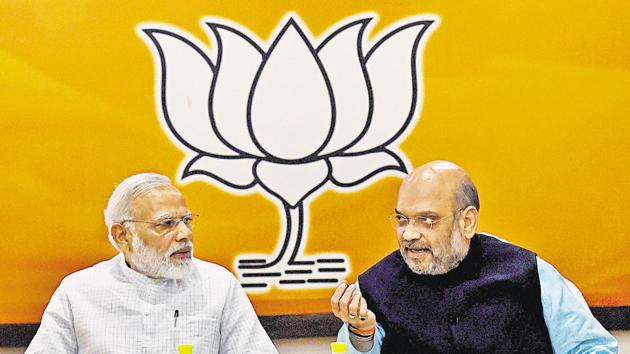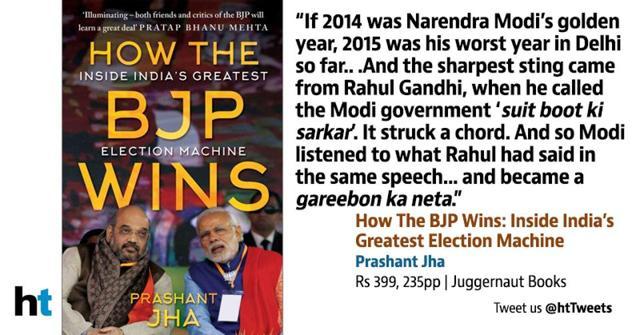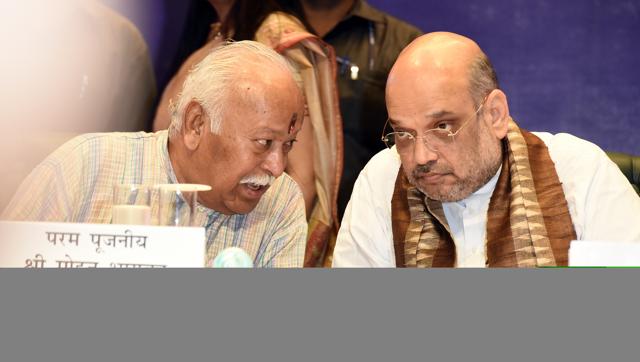How does BJP succeed in relentlessly acquiring power, state after state?
Prashant Jha’s new book closely examines how the BJP has maintained its winning streak. Here, he writes about the four big lessons he learnt while covering elections
Five years ago, few could have imagined India’s President, Vice President, Speaker, Prime Minister and Chief Ministers of over a dozen states would be from the BJP.

Fascinated by how the BJP not only won 2014, but has succeeded in relentlessly acquiring power, state after state, I kept a close watch on the party while covering elections for Hindustan Times.
Here are four big lessons I learnt which feature in my book:
1. When Modi listened to Rahul Gandhi
If 2014 was Narendra Modi’s golden year, 2015 was his worst year in Delhi so far. The famous suit, plastered with his name, made it appear like power had got to him. The government had to backtrack from amending the Land Acquisition Act, which made it look ‘anti farmer’. The foreign trips made him look disconnected. Delhi was a debacle and Bihar a humiliation.
And the sharpest sting came from Rahul Gandhi, when he called the Modi government ‘suit boot ki sarkar’. It struck a chord.
And so Modi listened to what Rahul had said in the same speech. The Congress leader had advised the PM to shift to the side of labourers and farmers and the poor - they were more in number after all. And Modi, who had moved from being a Hindu samrat between 2002 and 2007 to a vikas purush from 2007 to 2015, became a gareebon ka neta.
The narrative around demonetisation - as a battle of the honest poor versus the corrupt rich - was a step. The sharper focus on welfare - particularly Ujjwala scheme of distributing free LPG cylinders - worked. The government used the infrastructure laid out by UPA - Aadhar, the Socio Economic Caste Census, DBT - and ran with it to improve delivery partially. Modi waived off farmer loans in UP. He became a messiah of the poor.

2. The BJP is neither an upper caste, nor a solely north Indian, party anymore
BJP has moved from being an exclusivist Hindu party of upper castes to an inclusive Hindu party of all castes.
Amit Shah has done this through two key tools. The first is the organisation. In UP, he and his key aide Sunil Bansal, found - to their shock - that only 7 percent of the office bearers were OBCs and 3 percent were SCs in 2014. In 3 years, this increased to 30 percent. This is a part of the larger organisational strengthening, from the booth level to the top.
Second, he constructed an alliance of the socially dominant but politically marginalised (upper castes) with the socially and politically marginalised (specific OBC and Dalit sub castes) against the dominant political castes. The Yadavs in UP, Marathas in Maharashtra, or Jats in Haryana now confronted a challenge - and lost. BJP embraced the most visible and most invisible castes.
If Shah changed the caste character of the party in the heartland, general secretary Ram Madhav made it national by expanding in the Northeast. BJP wooed local leaders like Himanta Biswa Sarma or N Biren Singh; it diluted its ideological core and respected the cultural diversity of the region; it adapted itself to specific realities, be it raising extra judicial executions or becoming the Bharatiya ‘Jesus’ Party for Christian tribals.

3. The Sangh cannot enable a win alone, but can ensure defeat
In an interview a month before the Bihar election, the RSS chief, Mohan Bhagwat, supported reservation in principle, critiqued its politicisation and asked for its review.
Lalu Prasad ran with it to suggest the BJP would scrap reservations if elected. This shattered BJP’s chances.
The Sangh - either by such statements or sitting quiet - can make the party lose election. But on its own, it cannot make BJP win an election.
At the same time, it is the source - most BJP leaders owe their worldview and networks to the Sangh - and the supplement. It deploys pracharaks to quietly mobilise voters - and get them out on polling day; its vast network of swayamsevaks and sympathisers - professors, businessmen, shopkeepers, traders, journalists, labour leaders, students - also build a climate for the party.
Under the previous NDA government, this network of Sangh often did not own the government entirely. Under Modi, it does. The personal equation between Modi and Bhagwat; ideological convergence on issues ranging from gau raksha to Ganga and quest for Hindu unity; and close coordination on policy and personnel has meant Sangh deploys its resources. This is invaluable, especially in areas where the BJP organisation is weak. Where its own organisational strength has grown, it needs the mother-ship less.

4. ‘Secularism’ is dead
The BJP creates, sustains, and sharpens Hindu-Muslim tension. Take UP. Its project was based on deception, from the theory of ‘love jihad’ to the stories of Hindu migration from Kairana; from alleging the state government favoured Eid over Diwali to portraying Hindus as the major victims of Muzaffarnagar when it was mostly Muslims who suffered. This is politics at its most cynical and dangerous.
But I did not hear a single Hindu voter - even when he was a Congress, SP or BSP voter in UP or a JD(U) or RJD voter in Bihar - use the word ‘secular’ or ‘communal’. This was not a determinant of his voting decision. Indeed, secularism was merely seen as the quest for Muslim votes. And the more parties spoke of the minority vote - Mayawati giving 100 seats to Muslims or Congress-SP allying to consolidate Muslims were seen as examples of this - the more it helped BJP consolidate the majority.
But what about Bihar, one may well ask?
Even in Bihar, the now broken Mahagatbandhan won not by highlighting secularism but by downplaying it. Lalu Prasad told Muslim leaders to go back home and appear only on polling day; Muslim leaders told Nitish Kumar not to even mention them and focus on the Hindu vote - all of it was aimed to prevent ‘polarisation’. Old ‘secular’ politics won by hiding away the ‘secular’ rhetoric.

Future of the hegemon
This does not mean BJP is invincible. Delivering to both the middle class and poor will be a challenge for Modi. Managing caste contradictions will be a herculean task for Shah. There is likely to be a trade off between the Hindutva agenda and inclusive governance. And as soon as a bigger section of the Hindu vote allies with a block of Muslim vote, the game turns. The state of the opposition will also determine the BJP’s fortunes.
But for now, to understand India, understand how the BJP wins.
Read more: Why rural UP, small towns are ready to give Modi a chance on demonetisation




